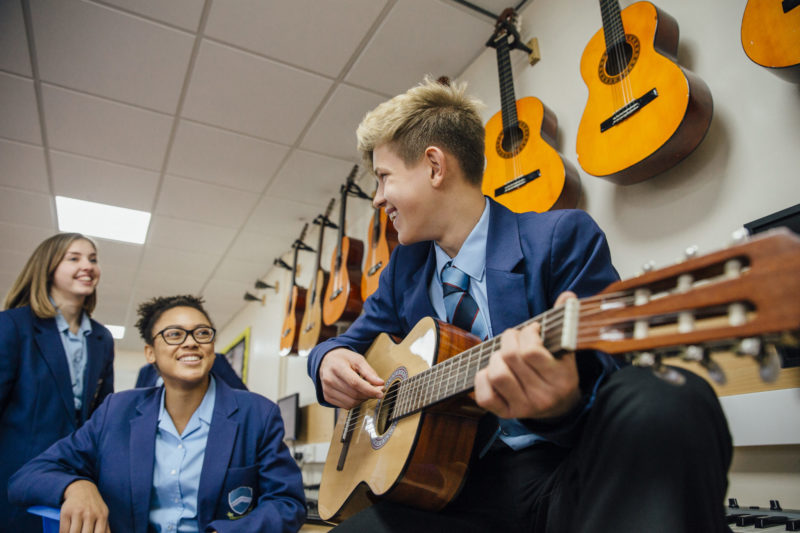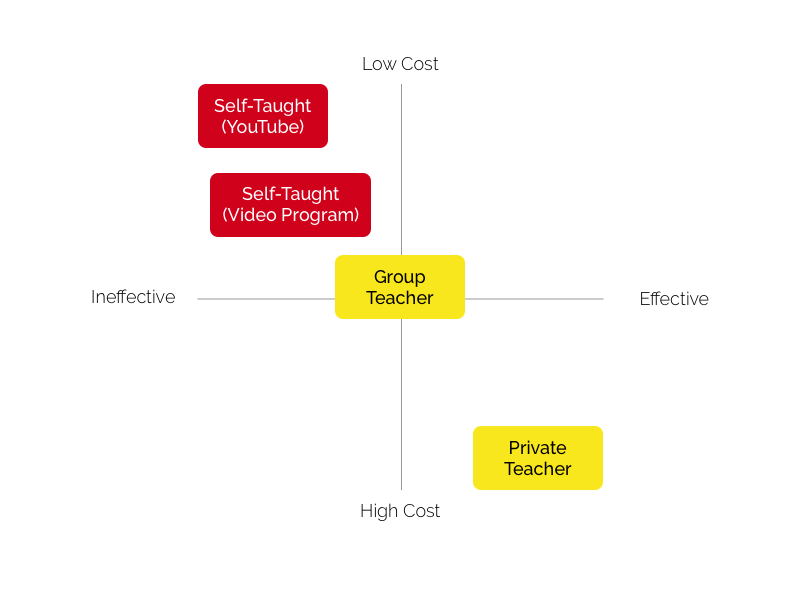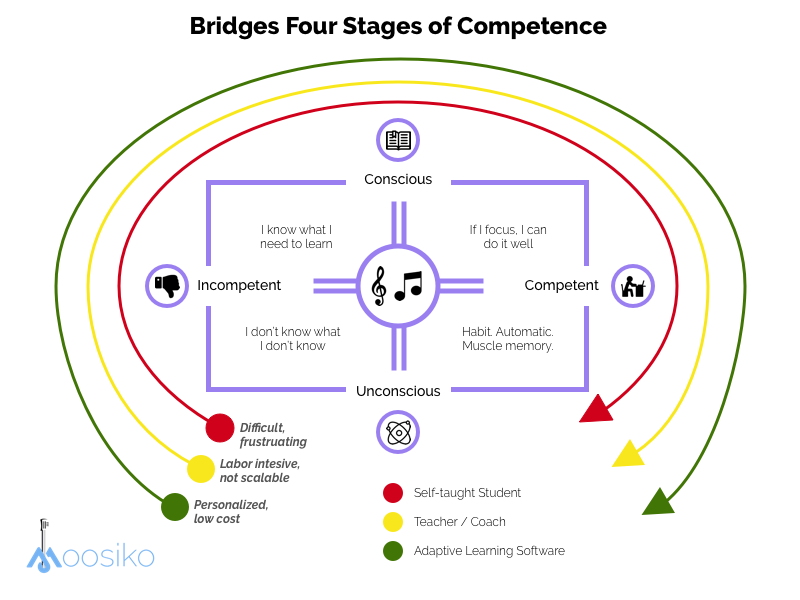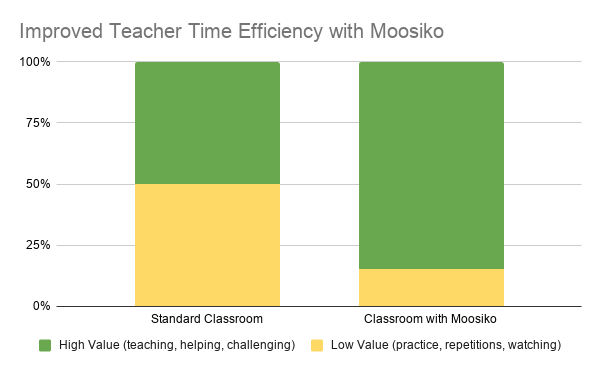Music education plays a critical role in the pursuit of a well-rounded student. And the benefits are vast: enhanced math, reading, and cognitive skills, improved memory, better fine motor skills, encouragement of sociability and expressiveness…just to name a few. Learning music wires our brains to think more creatively and effectively. At a young age students can either get exposure to learning and playing music, which for most becomes a lifelong skill, or music instruction can be overlooked or ineffective and students miss out on this life changing opportunity. Let’s face it, at some point, everyone kinda wants to be a rockstar.
Unfortunately music funding in public education is typically the first to go during budget cuts, which results in two outcomes: music programs are cut completely or they become too general where students never learn how to play an actual instrument. The recent pandemic and distance learning is yet another obstacle for music programs. For the same cost as a lesson book, Moosiko is using adaptive learning technology to support existing music programs to keep costs low while providing the necessary specialized instructions so students effectively learn to play an instrument they love.
Let’s look at how adaptive learning technology can have this tremendous, yet affordable, impact on music education.
How to Learn an Instrument
Looking at the music education landscape, there are only a few paths to learn an instrument:
- Self-Taught: This includes students that buy a lesson book, watch YouTube videos, sign up for online programs, or just pick up an instrument and start messing around by yourself or with friends.
- Private Teacher / Coach: This one-on-one setting can include instruction from a friend/family member, private lessons (in-person or virtual), or homeschooled children.
- Group Classes: This one-to-many setting includes K-12 music classes, private guitar schools, or after school programs.
These various paths have their pros and cons as it relates to cost and effectiveness. Learning to play guitar watching YouTube videos is free, however students quickly get discouraged due to the overwhelming content and lack of quality control making it the least effective way to learn. Private, one-on-one instruction is by far the most effective, but also the most costly. We can see the relation between cost and effectiveness by plotting these learning paths on the following chart.
You can see that group teacher splits the difference between cost and effectiveness. While you get scale by teaching in a one-to-many environment, you lose personalization which is important in music because of the variety of musical tastes from Taylor Swift to Blink182 to The Beatles.
The ideal learning path is a low cost, scalable solution that can provide personalized instruction at an individual level. This is exactly the benefits that adaptive learning technology can have on music instruction.
In order to see how adaptive learning can increase effectiveness while remaining affordable, let’s examine learning an instrument through the lens of a student making their way around Bridges four stages of competence.
- Self-Taught: This is by far the most difficult path. Most students never leave the unconscious-incompetence stage because they don’t even know what to practice or play. They don’t know what is good instruction vs bad instruction. This quickly leads to discouragement and frustration which is why 90% of people that try to learn the guitar quit in the first few months.
- What you hear from students: “I learned a few chords on YouTube but I can’t play any songs and I don’t know what to learn next.”
- Teacher / Coach (private): This is the most effective path but also the most expensive. A teacher or coach is able to guide the student through each stage, providing a completely personalized learning path and giving enough motivation to build the necessary muscle memory and skills to be proficient and beyond.
- What you hear from students: “I love my guitar teacher and have learned a lot over the past year. I’ve spent about $3,000 to get where I am today.”
- Teacher / Coach (group): This splits the difference. Group classes are cheaper because more students can participate, however individual personalization is sacrificed. While a few students might be self-motivated enough to carry them through, most will not and lose motivation along the way.
- What you hear from students: “Classes (or video content) was fun at the beginning, but they never taught songs I like. I stuck with it for a few weeks but then lost interest.”
Adaptive Learning Technology in Music
Adaptive learning combines the best of both worlds by leveraging asynchronous learning methods while providing a fun, personalized, and effective approach to learning an instrument that can be supported by the skills and expertise of the teacher. Since adaptive learning is software driven, it can scale quickly and is affordable.
Moosiko is pioneering the use of adaptive learning technology in music with our online guitar learning platform. Moosiko’s song-first approach means students can choose songs they love in order to make that emotional connection while creating a customized learning path to build skills quickly.
It works like this.
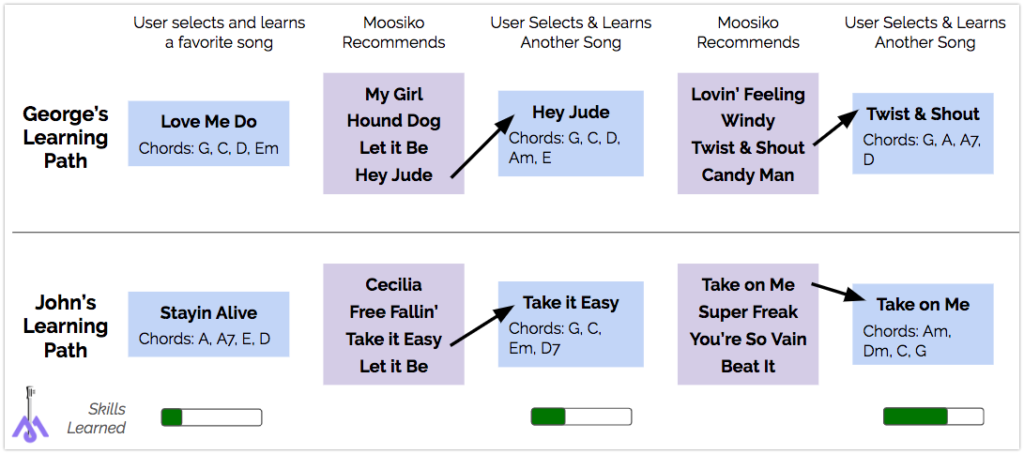
Moosiko provides a personalized learning path via students’ favorite songs
Every student receives a personalized learning path via their favorite songs. Not only is this more enjoyable but it increases effectiveness by teaching the exact skills the user should learn next. Students never need to think about “What do I need to learn?” because Moosiko guides them through all four stages of competence automatically.
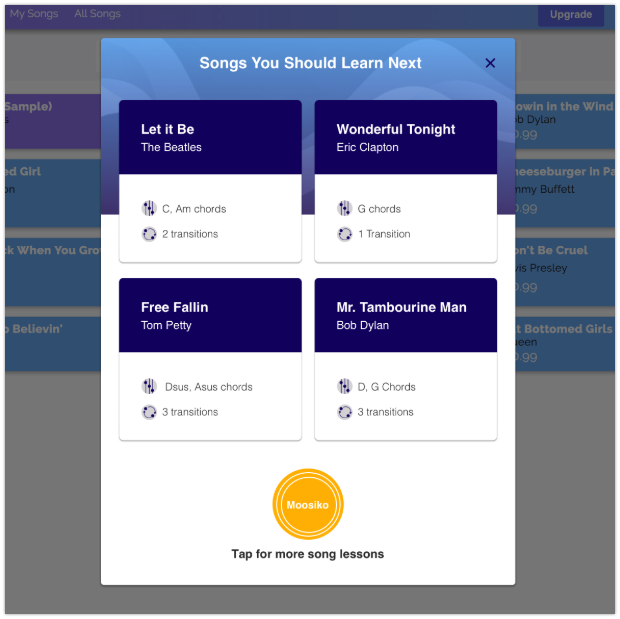
Moosiko platform suggesting which songs a student should learn next based on their skills
Improving Teacher Time Efficiency
Technology will never be able to replace teachers. Teachers have a tremendous ability to “read the room”, adjust curriculum on the fly, and provide pinpoint feedback to maximize learning efficacy. Technology needs to work to enhance these qualities in the classroom by freeing up time from some of the more boring tasks (collecting & organizing assignments, distributing assessments, tracking engagement, finding & organizing materials).
Music instruction is especially ripe for adaptive learning to play a big role due to the necessary physical practice that is required to learn an instrument. While repetitive practice is necessary, it is low-value teaching activity. No teacher wants to sit around watching while kids practice, they want to teach new skills or help when students are struggling, which is a much higher value for their time spent.
Here is how adaptive learning technology can optimize a teacher’s time to ensure they are spending it on high value teaching tasks and less on some of the boring/tedious tasks.
And when students have specific challenges or need help with a particular skill, the teacher is there to provide it. Moosiko guides students through the tedious tasks of learning outside the classroom while the teacher can focus on the high-value tasks inside the classroom. By optimizing the teachers’ time, learning programs are able to be both effective and cost efficient at the same time.
Saving Music Education
Learning to play an instrument like guitar isn’t that hard. Learning to type on a keyboard or text on a phone is much much harder, yet we all figure out how to do that. Unfortunately music programs continue to get cut or scaled back. Using adaptive learning technologies like Moosiko combined with smart and motivated teachers, music programs can create an environment of high success within the necessary budget constraints. A world with more music can only be a good thing!
If you’re interested in learning how Moosiko can support your guitar program, click here to schedule a short demo with us.

